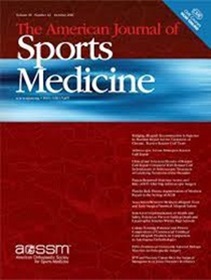Association Between the c.34C > T (rs17602729) Polymorphism of the AMPD1 Gene and the Status of Endurance and Power Athletes: A Systematic Review and Meta-Analysis.
IF 9.3
1区 医学
Q1 SPORT SCIENCES
引用次数: 0
Abstract
BACKGROUND Previous research has shown that variants in the AMPD1 gene, which encodes the adenosine monophosphate deaminase 1 (AMPD1) protein, may affect energy supply of the muscle and fatigue resistance during high-intensity exercise. A single nucleotide substitution in this gene, specifically a cytosine-to-thymine substitution (c.34C > T; rs17602729), results in a nonsense mutation that causes a deficiency in the AMPD1 protein. Deficiency of the AMPD1 protein due to this polymorphism can influence exercise performance, ultimately affecting the likelihood of reaching the status of elite endurance or power athlete. OBJECTIVE This systematic review and meta-analysis aimed to investigate the distribution of CC, CT, and TT genotypes of the AMPD1 c.34C > T polymorphism (rs17602729) in endurance and power athletes to assess potential associations between this polymorphism and elite athlete status. METHODS Studies investigating genotype distribution in the AMPD1 c.34C > T (rs17602729) polymorphism in endurance and/or power athletes were searched for in four electronic databases (PubMed, Web of Science, Scopus, Science Direct). The studies were selected and the genotypic and allelic frequencies of the AMPD1 c.34C > T (rs17602729) polymorphism were extracted if data for endurance and/or power athletes were compared with controls (non-athletes). Meta-analyses were computed using fixed or random effects models to calculate odds ratios (OR) with confidence interval (95% CI). Heterogeneity of the meta-analyses was reported using I2 statistics. RESULTS After examining 1229 studies on the distribution of the AMPD1 c.34C > T (rs17602729) polymorphism in endurance and/or power athletes, 20 studies were considered eligible to be included in our meta-analysis. The studies were conducted in 11 different countries, including 5717 participants. There was a higher frequency of the CC genotype (OR 1.72; 95% CI 1.40-2.12; p < 0.00001) in endurance athletes compared with non-athletic controls with a lower frequency of CT (OR 0.61; 95% CI 0.49-0.75; p < 0.00001) and TT genotypes in endurance athletes versus non-athletic controls (OR 0.43; 95% CI 0.19-0.97; p = 0.04). A higher frequency of the CC genotype was also observed in power athletes compared with controls (OR 2.17; 95% CI 1.69-2.78; p < 0.00001) with a lower frequency of the CT (OR 0.51; 95% CI 0.39-0.65; p < 0.00001) and TT genotypes (OR 0.25; 95% CI 0.09-0.68; p = 0.007) in power athletes compared with controls. Overall, the genotype distribution of the AMPD1 c.34C > T polymorphism (rs17602729) was similar in endurance and power athletes (OR between 0.76 and 1.39; p = 0.47-0.72). CONCLUSION Our findings indicate that the CC genotype was overrepresented in endurance and power athletes compared with controls, suggesting that possessing two copies of the C allele of the AMPD1 c.34C > T (rs17602729) polymorphism may be associated with a 1.72-2.17 times greater likelihood of achieving elite or sub-elite athlete status in disciplines reliant on aerobic and anaerobic metabolic pathways. No statistically significant differences were found in the AMPD1 genotype distribution between endurance and power athletes.AMPD1基因c.34C > T (rs17602729)多态性与耐力和力量运动员状态的关系:系统综述和meta分析
先前的研究表明,编码单磷酸腺苷脱氨酶1 (AMPD1)蛋白的AMPD1基因变异可能影响高强度运动时肌肉的能量供应和抗疲劳能力。该基因中的单核苷酸替换,特别是胞嘧啶到胸腺嘧啶的替换(c.34C > T;rs17602729),导致无义突变,导致AMPD1蛋白缺失。由于这种多态性导致的AMPD1蛋白缺乏会影响运动表现,最终影响达到精英耐力或力量运动员状态的可能性。目的本系统综述和荟萃分析旨在调查耐力和力量运动员AMPD1 c.34C > T多态性(rs17602729)的CC、CT和TT基因型分布,以评估该多态性与优秀运动员状态之间的潜在关联。方法在PubMed、Web of Science、Scopus、Science Direct等4个电子数据库中检索耐力和/或力量运动员AMPD1 c.34C > T (rs17602729)多态性的基因型分布。将耐力和/或力量运动员与对照组(非运动员)的数据进行比较,提取AMPD1 c.34C > T (rs17602729)多态性的基因型和等位基因频率。采用固定或随机效应模型进行meta分析,计算具有置信区间(95% CI)的优势比(or)。meta分析的异质性采用I2统计报告。结果在检查了1229项关于耐力和/或力量运动员AMPD1 c.34C > T (rs17602729)多态性分布的研究后,20项研究被认为符合纳入我们的荟萃分析。这些研究在11个不同的国家进行,包括5717名参与者。CC基因型的频率较高(OR 1.72;95% ci 1.40-2.12;耐力运动员和力量运动员的p T多态性(rs17602729)相似(OR在0.76 ~ 1.39之间;p = 0.47-0.72)。结论:与对照组相比,耐力和力量运动员中CC基因型被过度代表,这表明拥有AMPD1 C . 34c > T (rs17602729)多态性的两个C等位基因拷贝可能与在依赖有氧和无氧代谢途径的项目中获得优秀或亚优秀运动员地位的可能性增加1.72-2.17倍。耐力运动员和力量运动员的AMPD1基因型分布无统计学差异。
本文章由计算机程序翻译,如有差异,请以英文原文为准。
求助全文
约1分钟内获得全文
求助全文
来源期刊

Sports Medicine
医学-运动科学
CiteScore
18.40
自引率
5.10%
发文量
165
审稿时长
6-12 weeks
期刊介绍:
Sports Medicine focuses on providing definitive and comprehensive review articles that interpret and evaluate current literature, aiming to offer insights into research findings in the sports medicine and exercise field. The journal covers major topics such as sports medicine and sports science, medical syndromes associated with sport and exercise, clinical medicine's role in injury prevention and treatment, exercise for rehabilitation and health, and the application of physiological and biomechanical principles to specific sports.
Types of Articles:
Review Articles: Definitive and comprehensive reviews that interpret and evaluate current literature to provide rationale for and application of research findings.
Leading/Current Opinion Articles: Overviews of contentious or emerging issues in the field.
Original Research Articles: High-quality research articles.
Enhanced Features: Additional features like slide sets, videos, and animations aimed at increasing the visibility, readership, and educational value of the journal's content.
Plain Language Summaries: Summaries accompanying articles to assist readers in understanding important medical advances.
Peer Review Process:
All manuscripts undergo peer review by international experts to ensure quality and rigor. The journal also welcomes Letters to the Editor, which will be considered for publication.
 求助内容:
求助内容: 应助结果提醒方式:
应助结果提醒方式:


